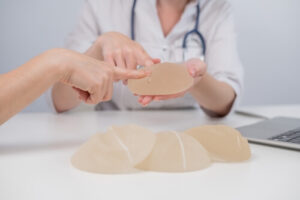Breast implants have become a significant topic of interest, not just globally but also in Australia. In the vast realm of cosmetic surgery, breast augmentation surgery is one of the most sought-after procedures. With a myriad of reasons driving individuals towards it, from the desire for a fuller appearance to breast reconstruction after health challenges like breast cancer, the relevance of breast implants in Australia is undeniably growing.
Breast augmentation, colloquially known as a ‘boob job’, involves the placement of silicone or saline implants behind the natural breast tissue or under the chest muscle to enhance breast volume and shape. The choice between silicone implants and saline implants often hinges on individual preferences and the advice of the attending cosmetic surgeon. Like all surgical procedures, breast augmentation carries risks, and potential candidates should be informed about possible complications such as capsular contracture or implant rupture.
The outcomes have become more refined with advancements in surgical techniques and a rise in expert cosmetic surgeons. But how do you determine the right implant type? Or what’s involved in the breast augmentation recovery process? This blog aims to delve deep into these questions, offering a comprehensive understanding of breast implants in Australia, from initial consultation to post-surgery care.
The History of Breast Implants in Australia
The journey of breast implants in Australia mirrors the global evolution of cosmetic surgery, marked by remarkable advancements and an ever-increasing understanding of the body’s anatomy. Historically, the allure of breast enhancement isn’t new. The desire to modify breast volume or address breast deformities led to various innovative, albeit not always successful, surgical procedures.
Initially, the breast augmentation procedure involved rudimentary methods that lacked the precision of today’s techniques. As cosmetic surgery began to ascent, Australian cosmetic surgeons sought better materials and techniques. Saline implants made their debut, providing a solution that contained sterile salt water. However, they would eventually be joined, and in many cases replaced, by silicone implants, valued for their more natural feel compared to the earlier saline counterpart. These implants, filled with silicone gel, became immensely popular among those seeking breast augmentation surgery.
Through the years, breast implant shapes have also evolved. From round implants that focused on adding volume, the industry saw the emergence of teardrop breast implants designed to mimic the natural slope of a breast. Alongside, surgical techniques improved, reducing risks and complications. The rise of the Australian Breast Device Registry further ensured safety, maintaining a record of implant procedures and their outcomes.
With the expertise of expert cosmetic surgeons, the evolution has been about more than just materials and individualised care. Breast augmentation consultation became integral, ensuring that each procedure caters to an individual’s unique body shape and needs.
Breast implants in Australia have indeed come a long way. From rudimentary beginnings to state-of-the-art surgical procedures and materials, the country has kept pace with, if not led, many global advancements.
Understanding the Procedure
Breast augmentation, known commonly as a ‘boob job’, has seen a surge in popularity globally and within Australia’s shores. When considering breast implants in Australia, understanding the procedure in-depth is paramount to ensure one’s aspirations align with the expected results and to be aware of the risks involved.
Overview of Breast Augmentation
Breast augmentation surgery is a cosmetic procedure designed to enhance the size and shape of one’s breasts. Whether the motivation stems from personal aesthetic goals, rectifying asymmetry, or reconstructing the breast post-cancer treatment, breast implants have become the go-to solution for many. The procedure can involve various implant types, with silicone and saline implants being the predominant choices. Each implant type, whether it’s filled with silicone gel or sterile salt water, offers unique benefits and is selected based on individual preference, body shape, and the cosmetic surgeon’s recommendation.
How the Procedure is Performed
The initial consultation with a breast augmentation surgeon is crucial. This is when discussions about implant size, breast implant shape (like the natural-looking teardrop breast implants or the more voluminous round implants), and placement either above the pectoral muscle or beneath the natural breast tissue occur. Surgical techniques have evolved, and the incision technique varies based on the chosen implant and individual anatomy.
Breast implant surgery typically involves making an incision, creating a pocket behind the breast tissue or beneath the chest muscle, and placing the implant. Smooth or textured implants might be chosen based on the desired outcome and the surgeon’s advice.
Recovery Expectations
Most women will experience discomfort, swelling, and bruising after breast augmentation. The breast skin might feel tight initially due to the added volume, but as the skin elasticity adjusts, this sensation subsides. The recovery period can vary, but breast augmentation recovery generally necessitates a few weeks of strenuous activities.
It’s vital to follow the aftercare instructions from the professional cosmetic surgeon to prevent complications such as capsular contracture (scar tissue forming around the implant) or implant rupture. Regular check-ups post-surgery are recommended to ensure the implants are in good condition and to monitor for potential issues.
While breast implants have provided countless individuals with renewed confidence and satisfaction with their body image, it’s essential to remember that surgical procedures carry risks. Comprehensive research, understanding potential risks and complications, and choosing a reputable cosmetic surgeon is crucial to ensuring a successful and satisfying outcome.
Types of Breast Implants Available
Breast augmentation surgery has experienced considerable advancements over the years. One of the primary choices every individual has to make when considering breast implants in Australia is between silicone and saline implants. Both have their merits, and the ideal choice often boils down to personal preference, guided by the recommendations of a cosmetic surgeon.
Silicone vs. Saline
Silicone Implants:
Silicone implants have garnered immense popularity due to their natural feel, closely mimicking natural breast tissue. These implants come prefilled with a thick silicone gel. Modern silicone implants are less prone to wrinkling than their earlier counterparts and have a reputation for aesthetic appeal. However, a potential downside is that if an implant ruptures, the gel might remain within the breast or scar tissue around it, making it harder to detect without imaging tests.
Saline Implants:
Saline implants are filled with sterile salt water after being placed into the body, allowing for smaller incisions during the surgical procedure. If a saline implant ruptures, the body safely absorbs the saline, and the rupture becomes immediately noticeable due to a change in breast volume. While saline implants might feel less natural, especially for women with smaller breasts or less existing breast tissue, they often appeal to individuals desiring a more straightforward solution in case of an implant rupture.
Advancements in Implant Materials


Research and patient feedback have driven these innovations, and the Australian Breast Device Registry plays a role in monitoring outcomes and ensuring patient safety.
Pros and Cons of Each Type
Silicone Implants Pros:
– Natural feel
– Less likely to wrinkle
– Variety in shapes, including teardrop breast implants
Silicone Implants Cons:
– Requires a larger incision
– Ruptures might be harder to detect
– Periodic imaging tests required
Saline Implants Pros:
– Rupture easily detectable
– Filled post-surgery, allowing adjustable volume
– Potential for smaller incisions
Saline Implants Cons:
– Might feel less natural
– Possibility of visible implant rippling
Ultimately, the choice between silicone and saline implants hinges on a comprehensive breast augmentation consultation with a professional cosmetic surgeon. Understanding one’s body shape, breast anatomy, and desired outcome is vital in making an informed decision. As with all surgical procedures, understanding the potential risks and complications is essential before cosmetic surgery.
Choosing the Right Surgeon in Australia
Deciding to undergo breast augmentation surgery is a significant choice, but selecting the right breast augmentation surgeon is equally vital. The quality of results, the experience during the procedure, and the care received post-surgery can vary significantly based on your choice of surgeon. Here’s what to consider when choosing a professional in Australia.
Importance of Board-Certification
Board certification is a testament to the competence and proficiency of a cosmetic surgeon. In cosmetic surgery, where procedures like breast implant surgery carry their own risks and complications, ensuring your chosen surgeon is board-certified by recognised institutions in Australia is paramount. This certification ensures that the surgeon has undergone rigorous training examinations and maintains ongoing education in surgical procedures and techniques.
Recommendations and Testimonials
Word of mouth remains a powerful tool even in the digital age. Recommendations from friends, family, or acquaintances who have undergone breast augmentation can offer valuable insights. Moreover, most reputable cosmetic surgeons have an online presence today. Prospective patients can explore reviews, testimonials, and before-and-after photos to gauge the surgeon’s expertise. It’s essential to look for consistency in results and positive feedback, especially concerning the surgeon’s professionalism, consultation clarity, and post-operative care.
Meeting with Potential Surgeons
An initial consultation is more than just an informational session. It’s an opportunity to gauge the rapport with the breast augmentation surgeon. During these meetings, discuss your desired outcomes, ask about the types of breast implants (like silicone implants or saline implants), and understand the surgical techniques they advocate. It’s also the time to raise any concerns or queries about the breast augmentation procedure, risks involved, recovery, and potential complications such as capsular contracture or implant rupture.
A commendable surgeon will ensure you have a comprehensive understanding of the procedure, including the type of implants, surgical site choices, incision techniques, and what to expect during breast augmentation recovery. They will consider your body shape, breast anatomy, and personal desires to craft a surgical plan that’s best suited to you.
Lastly, ensure your surgeon is updated with the latest advancements in the field and adheres to the Australian Breast Device Registry standards, ensuring safety and accountability.
When considering breast implants in Australia, remember that while achieving the desired aesthetic is crucial, safety should never be compromised. Trusting a board-certified, well-recommended professional cosmetic surgeon is a decisive step towards a successful outcome and a satisfying experience.
The Cost Factor
Breast augmentation surgery, a pivotal procedure in cosmetic surgery, remains an aspiration for many. However, when considering breast implants in Australia, the cost becomes essential in the decision-making process. Let’s delve into understanding the cost structure, variables influencing the price, and financial considerations.
Average Costs of Breast Implants in Australia
The cost of breast augmentation surgery in Australia can vary significantly based on several factors. On average, individuals can expect to pay anywhere from a few thousand to several thousand dollars. These figures can differ based on the region, the expertise of the cosmetic surgeon, and the surgical facility’s quality.
Factors Affecting the Price
Type of Implant: The choice between silicone and saline implants can influence the cost. Silicone implants, known for their natural feel, can sometimes be pricier than saline implants.
Surgeon’s Expertise: A highly experienced professional cosmetic surgeon might charge more than a less experienced one. While it might be tempting to opt for a cheaper option, it’s crucial to prioritise expertise and results over cost.
Surgical Facility: Undergoing cosmetic surgery in a state-of-the-art facility with modern equipment and experienced staff can be more expensive than in a standard clinic.
Additional Procedures: Women often opt for supplementary procedures like breast lift or reduction alongside primary breast implant surgery, increasing the overall cost.
Geographical Location: The cost of living and the demand for cosmetic surgeons in an area can influence the pricing. Major cities might have higher prices compared to regional areas.
Financing and Insurance Considerations
Health insurance typically doesn’t cover the costs of cosmetic procedures unless there’s a medical necessity, such as breast reconstruction surgery post-breast cancer. However, some cosmetic surgeons offer financing plans, allowing patients to pay in instalments.
It’s essential to understand the full spectrum of costs, including initial consultation fees, the surgical procedure, anaesthesia, post-surgical garments, medications, and any potential future surgery or breast revision surgery.
While the allure of overseas cosmetic procedures due to lower costs can be tempting, one must consider the risks and complications, the quality of healthcare facilities, and the potential difficulties in post-operative care.
Before deciding, potential patients should have a comprehensive breast augmentation consultation with their chosen expert. This discussion should clarify all expenses, allowing patients to make an informed decision, considering their aesthetic goals and budget.
In conclusion, while cost is undeniable, it should never compromise safety and quality. Breast implants are a significant investment in oneself, and thorough research and consultation are paramount to ensure a satisfying outcome.
Potential Risks and Complications
The decision to undergo breast augmentation surgery is a deeply personal one. While most women in Australia seek breast implants to enhance their body shape and self-confidence, it’s essential to be well-informed about the potential risks and complications associated with the procedure.
Common Side Effects Post-Surgery
Following the breast augmentation procedure, several immediate side effects are commonplace:
– Swelling and Bruising: It’s natural for the breast tissue and surgical site to exhibit swelling and bruising. This gradually subsides in the weeks following the surgery.
– Pain and Discomfort: Depending on the surgical techniques used and implant placement (above or below the chest muscle), patients might experience varying pain levels, typically manageable with prescribed pain relief.
– Changes in Nipple Sensation: Temporary or permanent changes in nipple sensation can occur post-surgery. Most women regain their sensation over time.
– Scarring: Incision technique and individual healing patterns can lead to visible scar tissue, though scars typically fade over time with appropriate care.
Long-Term Risks of Breast Implants
Beyond the immediate post-operative phase, some long-term risks and complications can arise:
– Capsular Contracture occurs when the scar tissue around the breast implant tightens, causing the breast to feel hard. It may require further surgery to address.
– Implant Rupture: Saline implants can deflate if rupture, while silicone implants might either stay intact or leak silicone gel into the breast. In either case, a surgical procedure would be necessary to replace or remove the ruptured implant.
– Implant Displacement: Implants might shift from their original position, leading to an asymmetrical appearance.
– Breast Implant Illness: A term used by some to describe a range of symptoms they believe are connected to their silicone breast implants, though there’s ongoing debate and research about its existence and causes.
Importance of Regular Check-Ups
Having breast implants in Australia means committing to regular check-ups and breast cancer screenings. These are vital for early detection of potential issues like implant rupture and ensuring the implants do not interfere with mammography. The Australian Breast Device Registry tracks the outcomes of individuals with breast implants to ensure patient safety and care.
Regular consultations with your cosmetic or breast augmentation surgeon can also help identify and address complications early. With the ever-evolving landscape of breast surgery, staying updated about new surgical procedures or implant types can be beneficial in the long run.
In conclusion, while breast augmentation can offer enhanced breast volume and a desired aesthetic, individuals must be proactive about their post-surgical health. Understanding risks, maintaining regular check-ups, and openly communicating with professional cosmetic surgeons can pave the way for a safe and satisfying outcome.
Preparing for the Surgery
Embarking on the breast augmentation journey is a transformative experience for many women in Australia. Ensuring optimal results from breast implant surgery involves diligent pre-surgery preparations. Here’s a comprehensive guide to help you navigate this pivotal phase:
Checklist for Pre-Surgery Preparations
Initial Consultation: Before the breast augmentation procedure, book an initial consultation with a professional cosmetic surgeon. This is the perfect opportunity to discuss your goals, understand the surgical techniques available, and decide on the implant type, be it saline implants, silicone implants, or textured implants.
Medical Assessments: Undergo necessary medical tests as your cosmetic surgeon prescribes, ensuring you’re in good health for the surgery.
Breast Cancer Screening: Given the significance of breast tissue in the procedure, consider a breast cancer screening to rule out any underlying issues.
Medications and Supplements: Some medications and supplements can increase the risk of bleeding. Discuss these with your surgeon, and make necessary adjustments before the procedure.
Lifestyle Adjustments: Refrain from smoking and limit alcohol intake as they can affect wound healing. If weight loss is on your agenda, aim to reach your target weight before the surgery.
Mentally and Physically Preparing
Mentally, preparing for cosmetic surgery is as vital as physical preparation. Understanding the surgical procedures and setting realistic expectations can significantly influence postoperative satisfaction. Additionally, strengthening chest muscles can aid in a smoother recovery. Physical exercises focusing on the chest wall, like push-ups, can be beneficial.
Setting Realistic Expectations
Having an open dialogue with your breast augmentation surgeon regarding the expected outcomes is essential. Understand that the aim is to enhance your natural breast anatomy and body shape, not achieve perfection. Having realistic expectations is crucial whether you’re seeking breast enhancement, breast lift, or addressing issues like tuberous breasts or breast deformity.


Lastly, familiarise yourself with potential risks and complications associated with the procedure. Being informed will allow you to make well-considered decisions throughout your breast augmentation journey, from capsular contracture to implant rupture.
In conclusion, proper preparation, both mentally and physically, is pivotal to ensure the success of your breast surgery. By taking these preparatory steps seriously and maintaining transparent communication with your professional cosmetic surgeon, you pave the way for a smoother procedure and a satisfying outcome.
Post-Surgery Care and Maintenance
Like all surgical procedures, breast augmentation surgery in Australia demands meticulous aftercare for optimal results and a smooth recovery. Your breast augmentation recovery is as pivotal as the procedure itself, and understanding post-surgery care ensures longevity and satisfaction with your new look.
Immediate Aftercare Instructions
Rest and Recovery: After breast implant surgery, most women require a period of rest. The chest muscles might feel sore, especially if the implants are placed beneath them.
Wound Care: Keep the surgical site clean and dry. Avoid any strenuous activities that could stress the incision technique or chest wall.
Medication: Your cosmetic surgeon will likely prescribe pain relievers and antibiotics. Ensure you take these as directed.
Wear Supportive Garments: A support bra can help manage breast skin elasticity, support healing, and contour the breast shape.
Monitor for Complications: Be vigilant about signs of infection or complications, such as unusual swelling, discharge from the surgical site, fever, or severe pain.
Limit Physical Activity: Avoid lifting heavy objects or engaging in high-impact exercises to protect the chest muscles and ensure the implants settle properly.
Long-Term Maintenance
Regular Check-ups: Stay updated with breast cancer screening and routine check-ups to monitor the condition of your implants. Utilise the Australian breast device registry for streamlined care.
Understand Risks: Potential long-term risks include capsular contracture, implant rupture, and scar tissue formation. Being informed helps in early detection and management.
Breast Self-Exams: Regularly check your breasts for any changes in shape, nipple sensation, or the presence of lumps.
Implant Updates: Breast implant technology continually evolves. Ensure you’re aware of advancements like teardrop breast implants, smooth implants, and textured implants.
Monitor Changes: Weight loss, natural breast tissue ageing, or further surgeries can alter the appearance of breast implants. Regular consultations with a professional cosmetic surgeon can help address these changes.
When to Contact Your Surgeon


Implant Concerns: If you suspect implant rupture, shifting, or any deformities, contact your breast augmentation surgeon.
Routine Follow-ups: Even if you feel fine, regular appointments with your cosmetic surgeon help monitor the health and position of the implants.
Cosmetic Concerns: If you’re not satisfied with the results or are considering future surgery, like a breast lift or breast reduction, your surgeon is the best point of contact.
In conclusion, post-surgery care and maintenance are paramount for the longevity and aesthetics of breast implants. Whether you’ve chosen saline or silicone implants, undergone a breast lift, or any other cosmetic procedure, following your surgeon’s guidelines and understanding the importance of long-term maintenance ensures the best possible outcomes.
Conclusion
The journey through breast augmentation in Australia requires careful consideration. From understanding the different types of breast implants available, such as saline and silicone implants, to appreciating the intricacies of the breast augmentation procedure, it’s clear that a well-informed decision is paramount. The health of your breast tissue, potential risks and complications, and the importance of choosing a professional cosmetic surgeon cannot be understated. Every individual’s journey will be unique, with options ranging from breast lift to natural breast augmentation and the potential for further surgery. While surgical techniques have advanced, and numerous breast enhancement options are available, being well-educated ensures your journey aligns with your body shape and expectations. If you’re considering cosmetic surgery, particularly breast implant surgery, we invite you to schedule an initial consultation with Refine Clinic. Our team is here to guide you every step of the way. Call us today at (02) 8599 7161 and embark on your transformative journey with confidence.
Note: Any surgical or invasive procedure carries risks. Before proceeding, you should seek a second opinion from an appropriately qualified health practitioner.
References:
https://www.fda.gov/medical-devices/breast-implants/risks-and-complications-breast-implants
https://www.aestheticreport.com/round-implants-vs-teardrop-implants/
https://www.breast-cosmetic-surgery.org/teardrop-breast-implants.html
https://www.plasticsurgery.org/cosmetic-procedures/breast-augmentation/implants/
https://breastimplantinfo.org/
https://www.fda.gov/medical-devices/breast-implants/things-consider-getting-breast-implants



